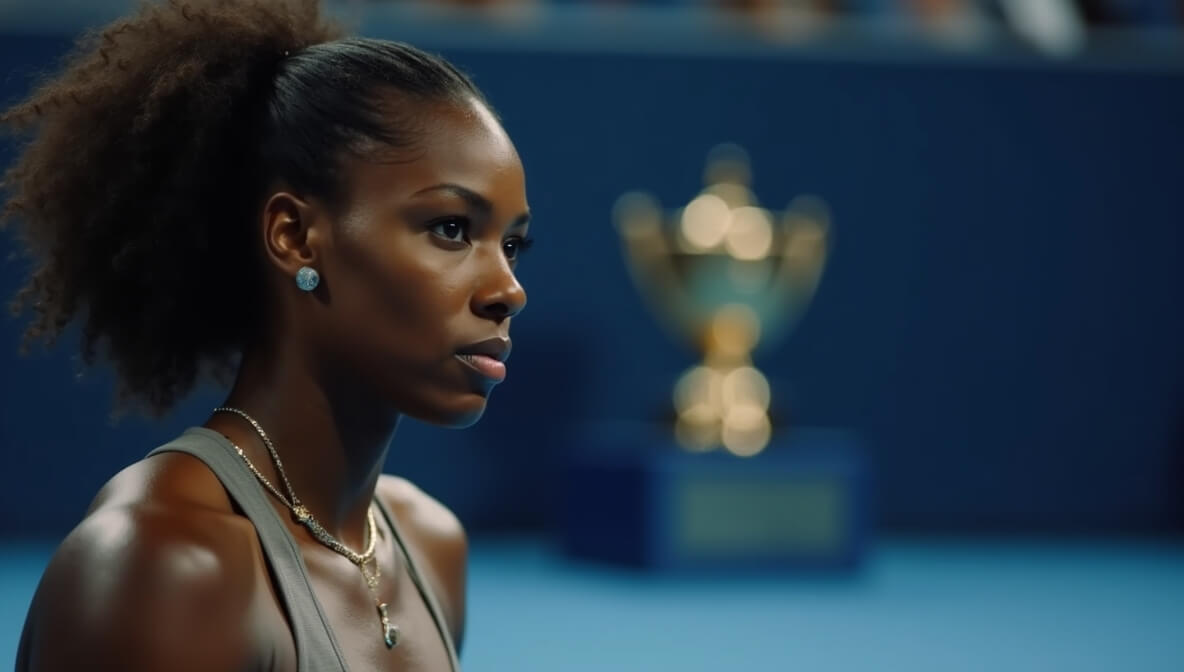Discover the untold story of Sloane Stephens and her secret struggle after her 2017 US Open win. Learn why she considered retiring at the peak of her career.
Dive into the surprising and emotional story behind the American tennis star’s biggest triumph and the secret battle that followed, revealing why reaching the top isn’t always what it seems.
What happens when you achieve the one dream you’ve chased your entire life? For most, it’s a moment of pure, unending joy. For an athlete, it’s the culmination of countless hours of sacrifice, sweat, and determination. In 2017, the world watched as Sloane Stephens completed one of the most remarkable comebacks in sports history to win the US Open. It was a fairytale. But behind the celebratory headlines and the gleaming trophy, a completely different and unexpected story was unfolding—one that almost led her to walk away from the sport forever.
This isn’t just another recap of a Grand Slam victory. At AJH World, we’re going deeper into the human story behind the athlete. This post explores the profound psychological reasons why Sloane Stephens questioned her entire career at its highest point. You’ll learn about the little-known phenomenon of post-victory depression, understand the pressures that follow monumental success, and discover how she ultimately rediscovered her passion for the game.
A Comeback for the Ages: The 2017 US Open Miracle
To understand the emotional depth of her post-victory struggle, you first have to appreciate the sheer impossibility of her win. Earlier in 2017, Sloane Stephens wasn’t thinking about trophies; she was recovering from major foot surgery. In a now-famous photo, she was sitting in a chair at the Tennis Channel desk, a huge cast on her leg. Her world ranking had plummeted to 957th. A comeback seemed difficult; a Grand Slam title was unthinkable.
Yet, she embarked on a blistering summer run. Unseeded and playing with a protected ranking, she tore through the US Open draw, showcasing a renewed power and mental fortitude. Her final victory against friend Madison Keys wasn’t just a win; it was a Hollywood script come to life. The crowd erupted, the world celebrated, and Sloane Stephens, against all odds, was a Grand Slam champion. It was, by all accounts, the perfect ending.
Or so it seemed.
The Champion’s Paradox: Reaching the Summit and Feeling Empty
The problem with reaching the top of the mountain is that there’s nowhere left to climb. After the cameras stop flashing and the confetti is swept away, a quiet, disorienting question can creep in: “What now?”
This is a well-documented phenomenon among high achievers, from astronauts who have walked on the moon to CEOs who have sold their companies. For elite athletes like Sloane Stephens, their entire identity and daily routine are structured around a singular, all-consuming goal. Every meal, every workout, and every decision is a step toward that championship.
When that goal is suddenly achieved, it can leave a massive void. The structure vanishes. The driving force is gone. Instead of elation, this can lead to feelings of:
-
Loss of Purpose: The “chase” is over, leaving a sense of aimlessness.
-
Intense Pressure: You are no longer the hunter, but the hunted. Every future match is measured against that Grand Slam-winning standard.
-
Identity Crisis: If you’re “the player who won the US Open,” who are you when you’re not playing or winning?

“The Hardest Part Was After”: Sloane Stephens on Post-Victory Blues
In various interviews following her win, Sloane Stephens was refreshingly candid about this difficult period. She explained that after the initial adrenaline and joy wore off, she felt overwhelmed and lost. The expectations, the demands on her time, and the internal pressure mounted to a point where she seriously asked herself if she should simply retire.
“I think after I won the US Open, I was like, ‘This is it. I’m done. I don’t know how I’m ever going to be able to top this.'”
This wasn’t about a lack of gratitude; it was a genuine psychological response to a life-altering event. She had achieved her ultimate dream, and the reality of what came next was daunting. She went on an eight-match losing streak after her win, a clear sign of the immense mental and emotional toll. It took immense courage for her to speak openly about these feelings, breaking the taboo that champions must always be invincible.
For deeper insights into the mental challenges athletes face, top sports psychologists at institutions like the American Psychological Association offer valuable resources.
More Than an Athlete: How Rediscovering Her “Why” Saved Her Career
So, how did Sloane Stephens pull herself out of that emotional spiral? She didn’t do it by focusing on winning another major. She did it by reconnecting with her identity outside of tennis.
Key Steps in Her Recovery:
-
Giving Back: She dedicated more energy to the Sloane Stephens Foundation, which helps provide opportunities for underserved children through tennis and education. This gave her a purpose that wasn’t tied to her on-court results.
-
Embracing Personal Life: She focused on her relationships, eventually marrying her longtime partner, soccer star Jozy Altidore. Building a life beyond the baseline provided balance and a stronger sense of self.
-
Reframing Success: She began to play tennis not because she had to prove anything, but because she loved to compete. She learned to find joy in the process again, separating her self-worth from her win-loss record.
This journey of rediscovery is what makes Sloane’s story so powerful. It’s a testament to her resilience and a vital lesson that true success is about sustainability and personal fulfillment, not just a single moment of glory.
2. What was Sloane Stephens’ ranking when she won the US Open in 2017?
When Sloane Stephens entered the 2017 US Open, she was ranked 83rd in the world. Just a few weeks prior, her ranking had been as low as 957th due to a long layoff from foot surgery, making her victory one of the most incredible comeback stories in tennis history.
3. Who is Sloane Stephens’ husband?
Sloane Stephens is married to Jozy Altidore, a professional soccer player who has played for the U.S. Men's National Team and in Major League Soccer (MLS). They got married on January 1, 2022.
4. Has Sloane Stephens won any other Grand Slams?
The 2017 US Open remains Sloane Stephens' only Grand Slam title to date. However, she reached the final of the French Open in 2018 and has been a consistent top player on the WTA tour for many years.
5. What is the Sloane Stephens Foundation?
The Sloane Stephens Foundation is a charitable organization founded by Sloane to provide more opportunities for underserved youth through education and tennis. This work became a key part of her journey to rediscover her purpose outside of her personal tennis achievements.
The story of Sloane Stephens and her 2017 US Open title is far more than a tale of a great athletic achievement. It’s a profound reminder that the journey doesn’t end at the summit. Her willingness to share her vulnerability about considering retirement reveals the hidden pressures of success and the human side of our sporting heroes.
Ultimately, she didn’t just win a trophy; she won a much tougher battle against the void that can follow a monumental victory. By finding purpose in giving back, embracing her personal life, and reframing her relationship with tennis, she crafted a second act in her career built on joy and balance, not just obligation. Her journey offers an inspiring blueprint for anyone who has ever reached a goal and wondered, “What’s next?”
What do you think is the biggest challenge athletes face after a major victory? Share your thoughts in the comments below!
The Fit Flair team is passionate about telling the deeper stories in sports, culture, and achievement. We believe in providing unique, human-centric content that inspires and informs our readers.Read more…..Shonda Rhimes’ Dazzling U.S. Open Look: The Story Behind Her Diamond Bracelet

